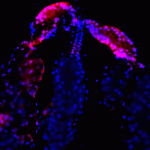Lien vers Pubmed [PMID] – 29497564
Virus Evol 2017 Jul;3(2):vex031
Like other pathogens with high mutation and replication rates, within-host dengue virus (DENV) populations evolve during infection of their main mosquito vector,. Within-host DENV evolution during transmission provides opportunities for adaptation and emergence of novel virus variants. Recent studies of DENV genetic diversity failed to detect convergent evolution of adaptive mutations in mosquito tissues such as midgut and salivary glands, suggesting that convergent positive selection is not a major driver of within-host DENV evolution in the vector. However, it is unknown whether this conclusion extends to the transmitted viral subpopulation because it is technically difficult to sequence DENV genomes in mosquito saliva. Here, we achieved DENV full-genome sequencing by pooling saliva samples collected non-sacrificially from 49 to 163 individualmosquitoes previously infected with one of two DENV-1 genotypes. We compared the transmitted viral subpopulations found in the pooled saliva samples collected in time series with the input viral population present in the infectious blood meal. In all pooled saliva samples examined, the full-genome consensus sequence of the input viral population was unchanged. Although the pooling strategy prevents analysis of individual saliva samples, our results demonstrate the lack of strong convergent positive selection during a single round of DENV transmission by. This finding reinforces the idea that genetic drift and purifying selection are the dominant evolutionary forces shaping within-host DENV genetic diversity during transmission by mosquitoes.

